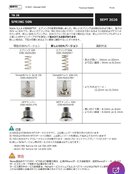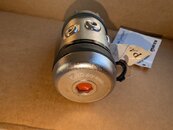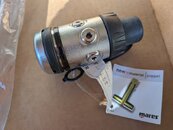Part 1
This guide is meant to help answer common questions about Mares regs of this century and to assist those interested in purchasing or resurrecting non-current regs.
A couple of notes. The following older regs that were still available in 2000 but were being phased out are not included: the MR10 and R1 first stages and the III, Navy and Beta second stages. Also, dates given are from Mares catalogs and manuals and in a couple of cases responses on the forum by Mares reps or service techs. These never exactly match dealer availability, in particular items were usually available in the shops for a couple of years after they disappeared from catalogs as existing stocks were sold out.
NAMING
First stage names are a number (2, 12, 15, 16, 32, 42, 52, 72, 82) and may have one or more letters as a prefix or suffix. The second stage names are normally a single word, e.g. "Abyss" and "Fusion", sometimes a suffix is added to indicate a special feature.
Note that Mares sells its regs as a packaged first and second. Their standard practice for package names is the second stage name followed by the first stage name, e.g. the "Carbon 52X". However, in the past they have sometimes used only the second stage names for the entire package. They have even marked the first stage with the name of its second stage on occasion.
The exception to package naming is for sales of standalone octopus second stages. Logically enough, these are called "Octopus" followed by the normal second stage name, e.g. "Octopus Rover".
FIRST STAGES
HP sealing systems
Mares' original balanced diaphragm first stage, the MR12, used a T-shaped poppet with a plastic laminate surface that pressed against a seat machined into the stage body to provide the seal between the high and intermediate pressure sections of the reg. This was typical practice of the time - in fact the original Mares poppet was interchangeable with the one used in Conshelf, Titan and other first stage - but could result in sealing issues causing air leaks from the second stage if either the poppet surface or seat were less than pristine. Poppets were dealt with by specifying replacement at 100 dives or 1 year. But rough or damaged seats required a new reg or expensive metal work by a specialist technician. Note that Mares wasn't the only company with this issue, a few techs in cave country apparently made a decent living treating HP seats from all the main manufacturers.
Mares spent several years working on improved sealing designs. The first step was to fit the MR12 with a replaceable seat. All of their balanced diaphragm first stage produced since then have replaceable seats. The next major effort was modifying the flat face of the poppet into a design that appears to have been inspired by a toilet plunger. The new poppet mated with a seat with a matching indent and the whole thing was called the Spherical Core Seal or SCS. In the end, SCS proved to be no better than the earlier design and was eventually dropped. Meanwhile, Mares engineers had been working on improved versions of the T poppet seal, culminating in the Tri-Material (brass, soft polyurethane, and high modulus polyurethane) design which first appeared in 2006. The Tri-Material poppets were a major advance, doubling the standard replacement schedule to 2 years - although still requiring 1 year inspections - and greatly decreasing the need for premature replacements. The Tri-Material poppets are still used in the 22 Navy and as replacement parts for the MR42. In 2015, Mares introduced the Advanced Coating Technology (“ACT”) poppets. These have a further improved sealing surface that have allowed Mares to switch to a two year inspection interval.
Here’s an old Mares video showing the the SCS and “classic” seals:
]
The good news is that, with two exceptions which are covered below, all Mares balanced diaphragm first stages can be upgraded to the current ACT system simply by swapping the poppet and possibly the seat (and minor accompanying parts such as the poppet pin and O-rings). Furthermore, they all use the same upgraded poppets and seats so there is no danger of an older reg being forced out of service by lack of parts availability.
Prefixes
MR - standard prefix for early balanced diaphragm first stages.
R - indicates piston first stage.
V - indicates SCS.
MR (again) - as SCS was abandoned, the prefix was changed to MR regardless of whether there was a previous MR version.
[no prefix] - the MR and R prefixes were dropped in 2015, at least in the catalogs. However I have seen a reg marked MR22X.
Suffixes
CWD - indicates factory installed cold water kit.
T - indicates uses tri-material poppet, the T suffix began appearing in 2008 to eliminate questions about whether the reg had the new style poppet.
S - ? May indicate “Short”. It only appears on the final version of the 12S and the current piston 2S.
X - indicates ACT poppet, first appeared in 2015 with the 52X and 15x






